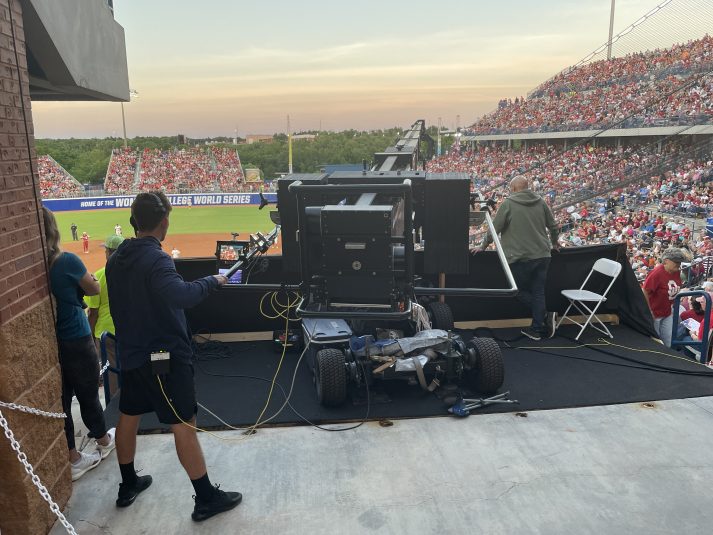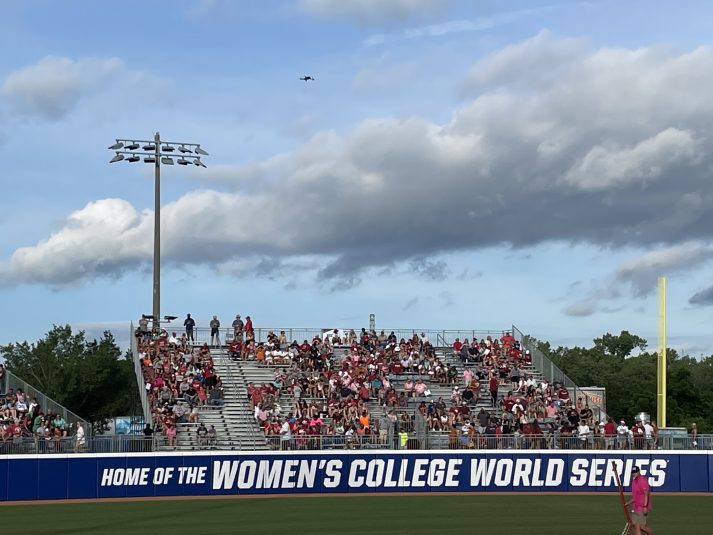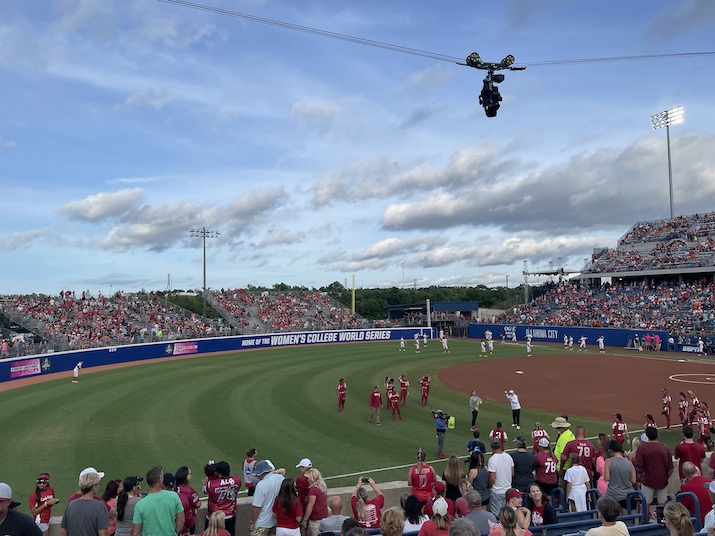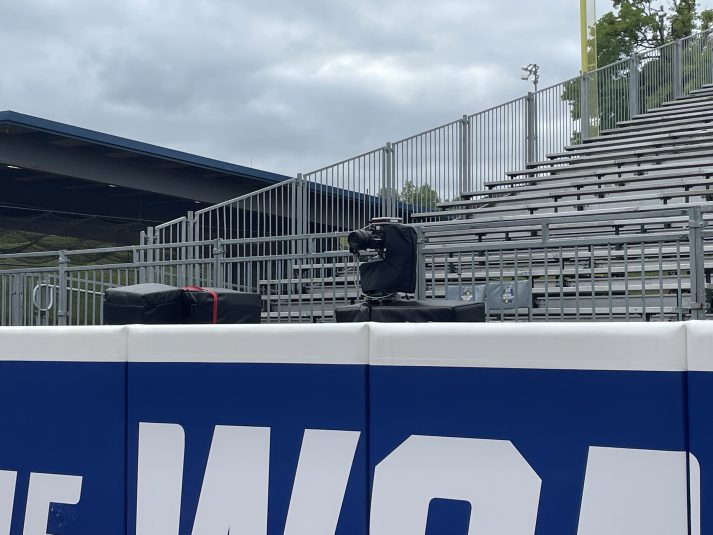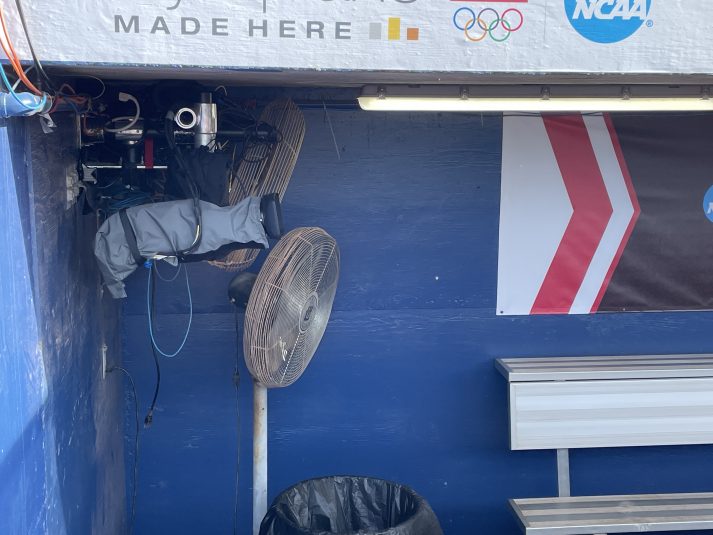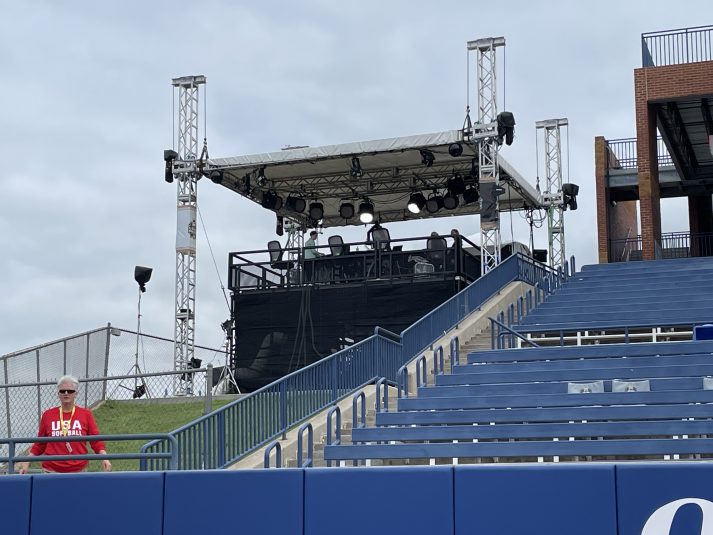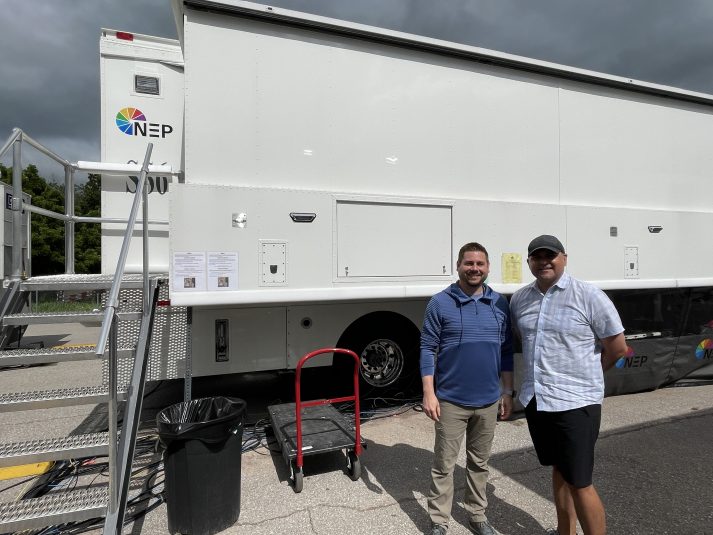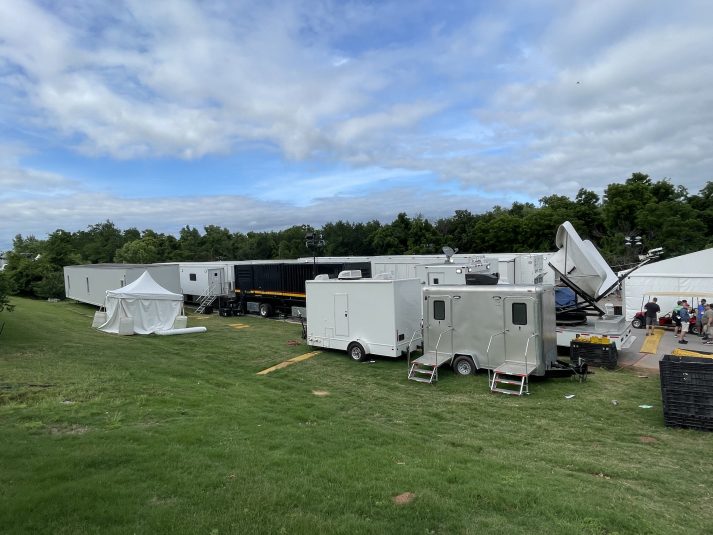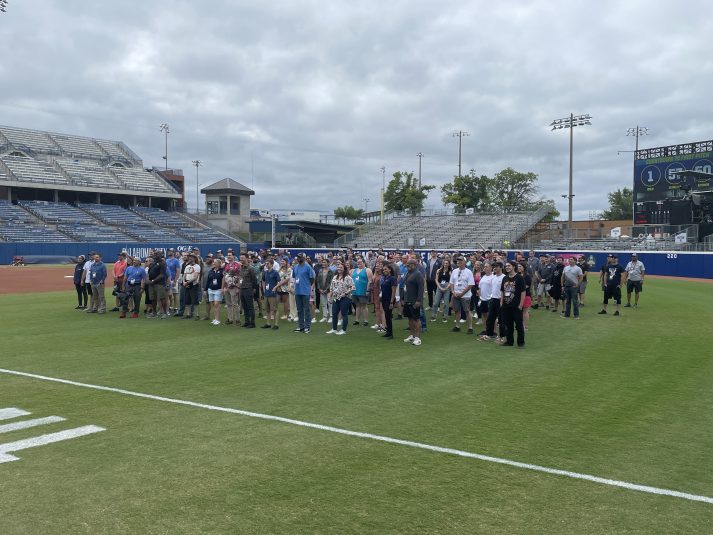Live From Women’s College World Series: ESPN Fields Full Onsite Production for Postseason Edition of Red River Rivalry
A team of 230 staffers is on hand for the 41-camera show
Story Highlights
The Oklahoma Sooners ran away with Game 1 of the Women’s College World Series (WCWS) Championship, but there’s always a chance for the underdog Texas Longhorns to make their mark in the final two games. At the center of the action, ESPN is taking over USA Softball Hall of Fame Stadium with an impressive tech arsenal, a bigger onsite presence, and an increased fervor to produce the best three-game series possible.
“We’ve made it past all 14 games of the tournament, so we’ve worked out all the kinks,” says Meg Aronowitz, VP, production, ESPN. “We’re ready to bring maximum excitement to this Championship Series.”
Additions to the Lineup: Technocrane, RF Drone Offer Stellar Aerial Views
Positive momentum has helped ESPN implement new and improved technologies for the nine-day-long competition. Inspired by the importance of the Championship Series, the broadcaster has exchanged its standard jib camera for an ultra-extended Technocrane. Positioned at the concourse level near home plate, the system fulfills multiple broadcast needs, providing elevated and sweeping angles on the left side of the field as well as filling potential holes in the aerial coverage. It has also become a helpful tool after the completion of the upper deck at USA Softball Hall of Fame Stadium.
“The arm can go up to 45-50 ft. in length, so it can get a lot of crowd reactions up in the upper deck,” says Thomas Mitchell, senior operations manager, ESPN. “We’ve also used it as our mid-third shot for color and game coverage.”
Higher than this massive structure, a drone is once again taking to the skies above the venue. Deploying an RF version of the device, the broadcaster tapped the services of New York City-based Xizmo Media Productions for this year’s tournament final. Last year, ESPN went with an internally driven drone operated via bonded cellular. With positive feedback from the viewing audience, the crew is not using a fixed-wing plane to avoid redundancies.
“The RF drone has given us some of the most dramatic and stunning shots of the tournament,” says Aronowitz. “We’ve gotten a lot more out of that than we thought possible.”
In the Thick of the Action: Two-Point Cable Cam Travels Above the Left-Field Line
Having turned heads during the 2021 WCWS, Cable Cam has returned to the production. Provided by Supracam, the two-point system runs from the backstop above the press box, down the stands, and past the foul pole along the left-field line.
Since its inception, the camera has added an extra layer to the broadcast. It has slowly become the star of the show and is used for a fair number of aerial replays, but the camera can be a sitting duck in a sport where balls fly off bats at high speed. The Cable Cam fell victim during Texas’s 7-2 loss to Oklahoma in the opening round on Saturday. With one out in the bottom of the first, senior Mary Iakopo hit a pitch foul to the left side into the stands, and her line drive smacked the idle Cable Cam square in the lens. As always with live production, the ability to adjust mixed with luck goes a long way.
“There was a jam on a focal part of the lens,” says Mitchell. “One of our technicians went up to the roof [of the press box] to check out the camera, found out that the lens basically got locked but didn’t shatter. We realized that we had a spare lens in the truck that would work, so they swapped it out within the course of an inning, and we were back to using it at full capacity extremely quickly.”
Cameras in the Clubhouse: Rail Cam, UmpCam, Three Super-Slo-Mos
Other notable cameras are part of the production’s 41-camera complement. Also returning to the diamond is the Rail Cam past the left-field fence. Outfitted with a Sony HDC-P1, the system runs 80 ft. from left field to center field and is capturing numerous highlights, from hits in the gap to dazzling plays with the leather.
Closer to the infield dirt, UmpCam has been installed on the mask of the home-plate umpire. Supplementing the live broadcast with engaging replays of a behind-the-plate point of view, this wearable device is managed by 3g Wireless.
The remaining camera layout comprises six hard cameras, three super-slo-mo units, 11 robotics, seven Marshall POVs, and a camera that moves from right field to inside the dugout.
All this technology is managed by hardworking production and operations teams. Besides Mitchell and Senior Operations Producer Kevin Wendling, the team includes Walt Disney Co. SVP Chris Calcinari; Director, Remote Production Operations, John LaChance; Director Anthony DeMarco; Senior Video Operator Roger McNally; Remote Graphics Operator Nicole Trimner; and EVS Operator Mike Pelkey.
Down on the Field: Current Pandemic Level Allows Increased Access
As the weather gets warmer, the broadcaster has more freedom to move about without worrying about the consequences of COVID-19. Unlike last year, when stringent health and safety restrictions were enforced, the production is flying without hindrances. Without these rules in place, ESPN is bringing back some of the techniques deployed prior to the pandemic. Extra access is also enabled by the NCAA.
“We’re back to having our onfield RF handhelds, which went away during COVID,” says Wendling. “The NCAA has also allowed us this year, for the first time, to follow the players on a dead ball down the third-base line, so we can be out on the field for home-run trots.”
On the audio side, the broadcaster has distributed 47 microphones throughout the field of play. All umpires on the field continue to be miked up. All RF audio is controlled by CP Communications.
Full House: NEP Supershooter 6, Supershooter 29 Park at the Front of the Compound
The improved pandemic situation also allows Aronowitz and company to work with a full team onsite. After much of the production was handled remotely and offsite last year, a crew of 230 credentialed individuals are on hand in Oklahoma City. Outside the stadium, NEP has a large command on workflows in the compound. Supershooter 6 A and B units continue to handle the live game production of each contest and also house graphics, replay, and a handful of edit teams. Two edit teams are located in ESPN’s Bristol, CT, facility, linked to the compound via a 3-GB pipeline — nearly 1.5 GB larger than in previous years.
Two other NEP trucks are at the heart of the production: Supershooter 29 is running the pregame studio show; the SRT mobile unit is providing ancillary support. Having everyone onsite has immediate production benefits: with personnel allowed to travel once again, the result is a more efficient and better broadcast.
“Energy is infectious,” notes Aronowitz. “Individuals working remotely aren’t able to feel the atmosphere of what’s happening onsite. They aren’t able to have one-on-one conversations with the director or producer or have the opportunity to think creatively in person. Having everyone onsite allows us to collaborate in real time and makes the show feel better because everyone is invested. For this event in particular, it’s extremely important to have everyone back [in the compound].”
Onsite Programming: Pregame Show, 7Innings Live Reside in Right-Field Set
Matching the intensity on the field is studio programming produced from an elevated studio set near the right-field stands. For live editions of 7Innings Live, Courtney Lyle will be joined by Danielle Lawrie, Madison Shipman, Amanda Scarborough, and Kayla Braud. The fun will continue with the pregame transitioning to a pair of alternative broadcasts not seen on the main linear feed. 7Innings Live: Championship Finals returns for its fourth year and will showcase unique insights from some of the best to play the game, along with special guests.
Returning for its third year, Pitch by Pitch will live-stream on ESPN3 during each of the three games. This specialized feed showcases every pitch from multiple angles. Each show is captured by two hard cameras, an RF handheld, a jib, and a robotic unit deployed for interviews.
This prime spot was not always available. An improved relationship with the host venue and five site surveys between January and June help Mitchell and the operations team push the envelope.
“It used to be a big grass hill,” he points out. “Once they built the new upper decks, we had to get some height to it, so we’ve worked with the stadium to get a concrete foundation for it.”
A height increase, not to mention playing the tournament in Oklahoma during the summer, promises weather-related obstacles. The most prevalent is the possibility of thunderstorms, severe winds, or even a tornado. In the case of inclement weather, three cameras will be deployed on an alternate set indoors.
“Affectionately known as the Rain Room,” Mitchell explains, “this can become another studio in the basement of the press room. It’s nothing glamorous, but it’s a safe place that we can continue to broadcast from as long as we still have the fiber and satellites.”
In the booth, Beth Mowins, Jessica Mendoza, Michele Smith, and Holly Rowe call the games in Oklahoma City. It’s their 15th Women’s College World Series together.
Tale of Two Teams: ESPN Aims To Close Out David vs. Goliath Series in Style
Whether there’s only one or two games left on the 2022 NCAA Division I Softball calendar, the two teams participating for the chance to raise a trophy are cut from two different cloths. The University of Oklahoma Sooners, the consensus No. 1 team in the nation, has a recent history of excellence: they’re the defending national champion, have appeared in three consecutive title series, and have been involved in four of the last five championship rounds dating to 2017. When you add redshirt senior Jocelyn Alo — arguably the greatest softball player in the history of the collegiate game — this Big 12 powerhouse is a formidable foe.
On the other hand, the University of Texas Longhorns aren’t supposed to be here. After they were winless in their first five regular-season games, the collegiate-softball community lost all hope of seeing burnt orange in Oklahoma City. Over time, the team regained both its swagger and sense of urgency. Peaking at the right time, they have become a force to be reckoned with in the regionals, the super-regional, and this iteration of the WCWS. Supported by a history of alumni who pack a punch, the squad from Austin became the first in the program’s 25-year history to make it to the final and also became the first unranked institution in the tournament’s 40-year history to make the final.
Storylines like these are hard to ignore, and, when you realize that these two universities are bitter rivals, the plot points become almost irresistible. At the front bench, the job becomes more exciting when the stakes are this high, and, given the upward trend in television ratings and the popularity of the sport, ESPN’s team aims to surround this festival with the technology it deserves.
“The show continues to grow every year,” says Aronowitz. “We’re extremely thrilled to be here in full force.”
Game 2 of the Women’s College World Series between the Oklahoma Sooners and Texas Longhorns begins Thursday, June 9 at 7:30 p.m. ET on ESPN2. If necessary, Game 3 will air on Friday, June 10 at 8:30 p.m. on ESPN.
